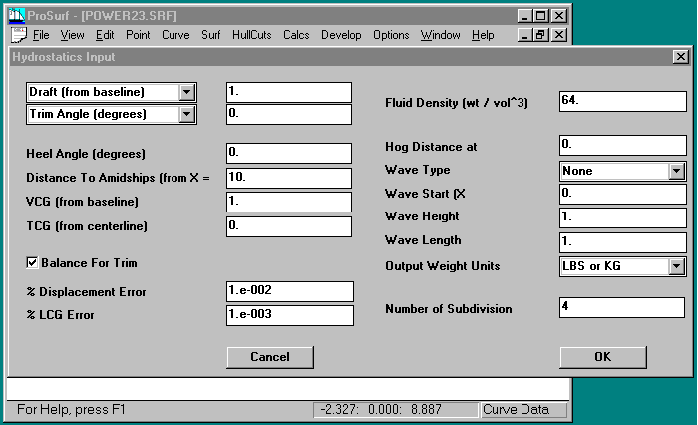At any time during the shaping and fairing of the boat, you can calculate its hydrostatic and stability information. You can even display the calculation results in their own window along side the display of the boat. The program will immediately recalculate the results after each change in hull shape. This is important if you wish to reach a target displacement for a fixed draft. This tutorial, however, will only use one window for the hull and the hydrostatic results.
To obtain the hydrostatics for the "power23" boat in this tutorial, follow these steps:
o Display the section (body plan) view of the boat
o Select the "Calcs-Hydro-Hydro Input" command to show the following dialog box

Although this dialog box provides many input fields to control the calculations, all of the fields have default values. The calculations can be done for any upright or heeled condition and can even search for the draft which matches a target displacement. This tutorial won't go into all of the options (see the program manual), so, to accept the default input values ...
o Select the OK button. The program requires you to open up this dialog box at least once, even if you do not wish to change the default values. Note that the calculations are not performed yet.
o Select the "Calcs-Hydro-Draw Stations" command. Since the hull is displayed in the section (body plan) view, the program will "cut" and display all of the stations to be used for the calculations. This step is not required, but it is a good idea to make sure that all of the cut stations look correct. If the stations cover the length of the boat and look correct, then the calculations will be correct.
Note that the Hydro Calc function will first cut the stations and then use these stations to perform all of the calculations. These stations must cover the entire length of the boat and are defined using the commands located in the "HullCuts" pull-down menu section. These stations have already been entered for this boat.
o Select the "Calcs-Hydro-HydroCalc" command to display the results of the hydrostatic calculation. Use the scroll bar to move throught the results. a part of the results should look like this:

If you enter a heel angle into the Hydro input dialog box, the program will first perform the calculation in the upright condition to determine the longitudinal center of buoyancy (LCB) (which is the same as the boat's longitudinal center of gravity (LCG)). The program will heel the boat and then sink and trim the boat to match the upright condition's values for displacement and LCB.